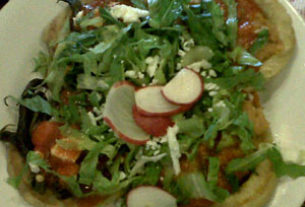Mexican Kitchen
From Cholula to Chicago, taco lovers everywhere know that any taqueria that calls itself poblana, or “from Puebla,” will have tacos arabes on the menu. But not everyone knows that this regional specialty of meat roasted on a vertical spit and served in the thick, pita bread-like wheat tortilla called pan arabe is a prime example of the Mexican- Lebanese culinary fusion that begun at the turn of the twentieth century.
Until recent years, Mexico did not have many restrictions on immigration, making it attractive to the Europeans and Middle Easterners who took part in the great movement to the Americas in the late nineteenth and early twentieth centuries. The Lebanese were part of that movement, attracted to Mexico by Porfirian development initiatives that encouraged foreign immigration.
In the years between 1880 and 1910, the first wave of Lebanese immigrants arrived in Mexico, driven from their native land by the oppression of the Ottoman regime with its political instability, economic competition and religious tensions. They arrived on Mexico’s eastern shores and settled in the Yucatan peninsula and the Gulf coast ports of Veracruz and Tampico.
During World War I, the Ottomans sealed off the entire mountain range that runs through central Lebanon, creating severe famine conditions. Many of those who could escape came to Mexico and became providers of food and arms during the Mexican Revolution. During the 1920s and 1930s, thousands more Lebanese arrived, and Mexico’s oil boom of the 1930s found most of them settling on the Gulf coast. Some got to Central Mexico in the 1920s and1930s, but it was not until the 1940s, with the influx of World War II refugees and the reunification of many Lebanese Mexican families, that large numbers of them migrated to Mexico City and Puebla.
The Lebanese community flourished in Mexico (Carlos Slim and Salma Hayek are among the Lebanese Mexicans whose names have become household words even outside the country) and, because of its strong cultural and familial ties with Lebanon, preserved a great deal of its heritage, especially the culinary traditions.
The food of Lebanon, which sits on the eastern shores of the Mediterranean, combines elements of European and Middle Eastern cuisine. The characteristically healthy Mediterranean diet features an abundance of fruit, nuts, vegetables, whole grains, fish and seafood. When red meat is eaten, it is usually lamb. Butter and cream are rarely used, except in some desserts, and most food is flavored with generous amounts of garlic, olive oil, spices and herbs. (Copious use of fresh herbs is a hallmark of Lebanese cooking, and in earlier times one of the questions considered when looking for a bride was how finely she could chop parsley.)
Although the largest group of Mexicans of Lebanese descent lives in Merida, it is in Puebla, with its own rich and complex gastronomic legacy, that Lebanese food became part of the regional culinary repertoire. Influenced by local ingredients, especially chiles, Lebanese cooks in Puebla developed their own unique takes on the food of their homeland.
The traditional spit-roasted meat called shawarma became the filling for tacos arabes, now most frequently made with pork instead of lamb, and marinated in a chile-flavored paste. Rolled in thick wheat tortillas and served with chipotle sauce, they are still clearly recognizable as a version of shawarma, as are tacos al pastor, a variation of tacos arabes in which the meat is roasted with a thick slice of pineapple atop the stack of thinly sliced pork. (The stack of meat is called a trompa, for its resemblance to a toy top, tapering to a narrow bottom.) When served on a corn tortilla instead of pan arabe, they are called tacos orientales.
Another Lebanese specialty that has been Mexicanized with local ingredients is kibbeh, an emulsified paste of fresh, lean ground lamb and bulgur wheat. Kibbeh nayee, whose name in Mexico has become kebe cruda, is a raw meat dish resembling steak tartare. Flavored with onions and spices, the kebe cruda in Puebla contains the addition of fresh chile seeds and is served with chopped green onions, chopped jalapeño or serrano chiles and hierba buena (mint.) It is almost always served with jocoque, a Mexican dairy product that originated with the Middle Eastern immigrants and tastes like a combination of sour cream and buttermilk. It is also quite often accompanied by a version of guacamole that uses tomate verde (tomatillo) instead of red tomatoes. Perhaps the slightly acidic flavor of the tomatillos recalls the pickled vegetable condiments of Lebanon, but in any case it is a decidedly Mexican addition to the serving of kibbeh.
Two other versions of kibbeh are kibbeh bil-saneeya, which became kebe charola in Mexico, and kibbeh rass, called kebe bola. The former consists of the ground meat and bulgur mixture pressed into a shallow pan, layered with meat and pine nuts, topped with another layer of the ground meat mixture and baked until cooked through. The latter is formed into patties, also filled with the meat and pine nuts, and fried. Another ground meat specialty is kafta, ground lamb with parsley and onion, formed into meat balls and most often served in tomato sauce or shaped around wooden sticks to make kebobs.
The Middle Eastern stuffed grape leaves became tacos de parra, finger-sized and stuffed with seasoned rice and ground lamb. Spinach turnovers became empanadas de espinaca, flavored with herbs, especially parsley and hierba buena, and spices. The garbanzo dip called hummus, the eggplant dip known as baba ganouj – called simply berenjena, or eggplant, in Puebla – and the herb and bulgur salad tabbouleh are all popular and have retained their distinctly Lebanese identity. And bread is served with all food at all meals. The flat pocket bread called pita is perfect for scooping up hummus, baba ganouj, jocoque, or kebe cruda. Sprinkled with the spice mixture zahtar, a blend of sesame seeds, sumac and thyme, pita is baked in the oven, cut into triangles and served as “chips” for dipping.
Lebanese desserts are very sweet, with generous amounts of nuts, dates, orange and rose flower waters, honey and sugar syrup. Specialty bakeries in Puebla and Mexico City sell a variety of Lebanese desserts, especially baklava. These are most often accompanied by coffee. Nearly all the Mexican fruit aguas are good accompaniments to Lebanese food.
The following recipes are a sampling of the food eaten by the Lebanese community of Mexico, especially at family gatherings and social events. They are ideal for buffets, such as that served at the Mexican Lebanese Cultural Center in Puebla, where they are accompanied by hummus, jocoque, fresh pita bread and pita chips. In Lebanon, these informal buffet dishes are called mezzes.
- Kebe Charola: Baked Kibbeh
- Kebe Cruda: Mexican-Lebanese Lamb Tartare
- Tacos de Parra: Stuffed Grape Leaves
- Pan Arabe con Zatar: Zahtar Bread


